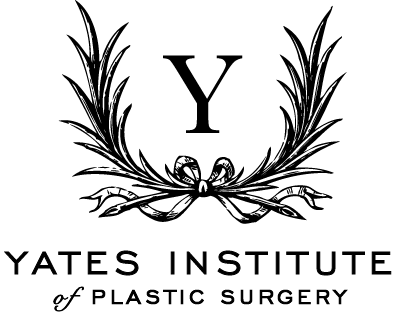
Face Lift Surgery
with Dr. Yates
What is a facelift?
A facelift (also known as rhytidectomy) is one of the most popular procedures for patients seeking facial rejuvenation. After a certain age, skin laxity becomes a real issue causing saggy skin at the level of the face. And when it comes to saggy skin, the most efficient solution and the golden standard is eliminating the excess skin.
There are various facelift techniques; during your consultation, Dr. Yates will advise you on which best suits your aesthetic goals. The facelift surgery can remove years off your face by smoothing down wrinkles and giving you a better definition for the jaw line.
The procedure is often performed in association with other plastic surgery procedures to achieve natural results. Dr. Yates will advise you if she thinks you need volume replacement in the cheeks at the time of your facelift. Volume can be added to better redefine the face using fillers. At the same time, with Botox injections, we can achieve even better results if the patient presents expression lines on the forehead. The facelift surgery is a safe procedure that has been performed for decades with high success rates.
What are other names for a facelift?
- Mini Facelift
- Lower Facelift
- Rhytidectomy
- Lifestyle Lift
What are the benefits of a facelift?
When visible signs of aging are present at the level of the face, the facelift is an efficient solution to getting rid of a few years from our faces and get a better contour and definition. The facelift procedure is a good choice if the patient is struggling with deep wrinkles, saggy skin, deep nasolabial folds, and undefined jaw contour. Here are just some of the benefits associated with getting a facelift:
- Smooths wrinkles
- Improves facial contour
- Decreases jowling
- Rejuvenates the face
- Makes you look younger
Am I a good candidate for a facelift?
Most people resorting to facelift surgery are men and women between 40 and 60 years old. However, the procedure can be performed on younger or older people, just as well. Good health and emotional condition are more important in determining your eligibility for the surgery than your actual age. Actually, facelift surgery can deliver spectacular results for patients over 60 years old.
Generally speaking, when it comes to plastic surgery, we say that the best candidates for the procedure are the ones with realistic expectations from the surgery. It is important to understand that undergoing a facelift surgery won’t make you look like in your 20s again, if you are now in your 50s or 60s, but it could certainly make you look 10 years younger.
Also, it’s important to understand that the face lift surgery won’t stop time. The aging process continues and you might develop wrinkles and skin sagginess after some time. To sustain and enjoy the results of your facelift procedure for as long as possible, it is recommended to have a balanced lifestyle, avoid smoking and excessive sun exposure and keep a good skincare routine.
A good candidate for the facelift procedure is a one that feels younger on the inside and wants to match this to the external aspect of the body.
Why undergo a facelift surgery?
Not having a balanced lifestyle in our youth can affect how we look and feel later on in life. Too much sun exposure, smoking, drinking, eating too much fast food are just some of the factors that could eventually lead to premature aging. And the signs of aging occur at the level of the face quite early in life, especially when all of these factors are present. This is the reason why we have patients as young as in their 40s undergoing the face lift procedure to get a rejuvenated look.
Some patients undergo the face lift surgery to celebrate a new beginning in their lives. Some of them are getting married for a second time and they want to look as young as they feel or even younger for their spouses. Others are looking for more opportunities in the work field. And there are quite a few patients undergoing the procedure just as a treat for themselves.
There are plenty of reasons why patients resort to the face lift procedure. A refreshed, rejuvenated look is just one of them, aside from the emotional benefits that could be associated with this.
Facelift surgery might be a good choice for you if you:
- Have deep nasolabial folds (the folds at the corner of the nose and up to the corner of the mouth)
- Saggy skin and wrinkles on the cheeks
- Undefined jawline
- Excess skin or fat tissue on the neck (in this case, the facelift is performed together with the neck lift)
The procedure should be carefully considered if the patient has:
- Blood pressure conditions
- Thyroid gland conditions
- Dry eye syndrome or other severe or chronic eye conditions
- Diabetes
- Cardiovascular conditions
While there are many sources of information about facelift surgery online, the best way to get the detailed info that is relevant for your particular case is to schedule a consultation with Dr. Yates.
How is the facelift surgery performed?
As mentioned before, there are many different surgical approaches that can be used during facelift surgery. The surgical plan is dependent on the individual characteristics of the patient and the aesthetic goals that need to be met. Dr. Yates strives to deliver 100% natural results with minimal scarring. This is the reason why, in a vast majority of cases, Dr. Yates will hide the incisions in the natural folds of the skin close to the ears or the hairline. As a result, the scars are barely, if ever, visible. Keep in mind that a small incision under the chin is necessary to get the best results.
After the incisions are performed, Dr. Yates will separate the skin from the underlying tissues and redrape the skin. The excess skin is eliminated, and the tissues are repositioned to achieve a better contour of the face. If it’s necessary, an incision under the chin will be performed to eliminate the excess of adipose tissue.
The incisions necessary for the facelift surgery are positioned over the hairline on the forehead and follow the natural line of the face along the ears and go behind the ear lobe.
What should I do to prepare for my facelift?
- Optimize your nutrition
- Stabilize your weight (it changes face shape)
- Grow out your hair if you have short hair (so it covers incisions whilst they heal)
- Avoid smoking for at least two weeks before the procedure (to ensure proper healing and minimize risks)
- Avoid taking certain medication (anti-inflammatory medication containing aspirin or similar)
Preparing for the face lift surgery also entails taking time off from work for the recovery period. Some patients can take just two weeks off from work, while others prefer to take more time off. Generally speaking, the bruising and swelling associated with the procedure should subside significantly within the first few weeks post-op, so you should be able to get back to your work responsibilities after two weeks.
However, if you prefer to take more time to rest and allow your body to heal after the intervention, this is also a good idea. You won’t have to worry about the incisions after the facelift surgery as they will be well-hidden in the natural folds of the skin and barely visible when they are fully healed.
How much does a facelift cost?
On average, $6,500, plus anesthesia and facility costs (approximately $3,500), however, each patient is different, and costs may vary based on complexity.
What is the recovery process for a facelift?
The procedure takes 3-4 hours to perform, swelling and tightness are normal postoperatively, scars take approximately 2-3 months to heal and fade entirely by 6months to 1 year. Most people take 1-2 weeks off work, six weeks off strenuous activity or heavy lifting.
Keep in mind that sleeping with your head elevated can help with the swelling and bruising. You can start applying makeup after the first-week post-op unless otherwise advised by the plastic surgeon. For the success of your intervention, it’s essential to avoid sun exposure throughout the healing process. More than this, make sure to use a cream with a high SPF factor for at least a few months post-op.
The results of the facelift are visible immediately after the surgery is performed, but the final results can take a few weeks or months to be visible (when the swelling subsides and the incisions heal completely). The facelift surgery delivers long-lasting results; the patients can enjoy the rejuvenated aspect of the face for five to ten years; however, this varies from one patient to the other.
What other procedures can be combined with a facelift?
- Neck lift
- Facial fat grafting
- Blepharoplasty and brow lift
- Fillers
- Botox injections
Facelift Surgery FAQs
What's it like to get a facelift?
Facelift surgery is a highly customized intervention. The surgical approach is different from one patient to the other and dependent on the physical characteristics of the patient, age, and aesthetic goals. In most cases, the facelift surgery entails a recovery period of no longer than two weeks. The recovery length depends on the intervention's complexity and the patient's age and health condition. It is normal to experience a certain level of discomfort after getting a facelift, but the pain is easily manageable with the help of analgesic medication. After getting a facelift, bruising and swelling are common occurrences – they usually subside without additional treatment in two to three weeks post-op. A tightness sensation at the face level can also occur, and you'll have to wear a head wrap for some time to help with healing.
What are the different types of Facelift procedures?
The facelift procedure is among the most popular plastic surgery interventions performed worldwide. However, getting your head around the terms used for the procedure could be confusing. There are many different types of facelifts. The differences between them are either related to the area of the face that is targeted or the surgical approach used. Among the different types of face lift procedures, we can mention deep plane facelift, SMAS facelift, mini facelift, midface lift, cheek lift, upper facelift, lower facelift, skin-only facelift, and brow lift. There are also other non-surgical options, such as the liquid facelift and the thread lift.
Is a facelift dangerous?
There are certain risks associated with facelift surgery, just like is the case with any other surgical intervention. Considering the fact that the facelift addresses a delicate and always visible part of the anatomy – the face – it is best to choose a talented and experienced plastic surgeon and follow the surgeon's recommendations to the letter to get the best results possible. Avoiding smoking and intense physical exercises after the surgery can help you minimize the risks.
What is a midface lift?
As we discussed before, there are many different types of facelifts. The midface lift surgery is a procedure targeting the signs of aging at the level of the middle of the face – from the upper lip to the eye area. The intervention is also known as a cheek lift.
Is a facelift a major surgery?
Considering the fact that a facelift is often performed with the patient under general anesthesia and that the procedure can entail work on the deep structures of the face, a facelift can be considered major surgery. It is a complex procedure that can rejuvenate the aspect of the face and erase signs of aging.
How to get a non-surgical facelift?
The non-surgical facelift is all about injectables. For younger patients, the non-surgical facelift might be a better option. This entails using Botox injections, dermal fillers, or a combination of the two to eliminate some signs of aging. Dermal fillers can be used to create more volume where it is needed for a plumper appearance of the face, while Botox can relax the muscles and make some wrinkles and deep lines disappear. Keep in mind that non-surgical or liquid facelift results are only temporary.
How many times can you have a facelift?
Depending on your needs and aesthetic expectations, you can have different facelift procedures throughout your lifetime. Some patients start with a liquid facelift in their 30s or 40s and then resort to surgery later in life to keep a youthful appearance. When it comes to SMAS or Deep plane facelift, the results are long-lasting; you can enjoy a rejuvenated appearance for up to ten years.
What is facelift surgery?
Facelift surgery, also known in medical terms as rhytidectomy, is the plastic surgery procedure performed to rejuvenate the face by eliminating some signs of aging. During the facelift procedure, the plastic surgeon can reposition skin, fat, and muscle tissue and remove excess skin that creates skin sagginess.
How to tighten the skin of my face?
Depending on your age and other physical characteristics, a surgical or non-surgical facelift can be used to get a firmer face. When skin sagginess is present, the suitable option is a surgical procedure. If you are confronted with just early signs of aging, fillers, and Botox can be used to give your skin a tight and firm look.
How does a non-surgical facelift work?
The non-surgical facelift often refers to using injectables to erase some early signs of aging. For example, Botox can be used to improve the aspect of the forehead area. At the same time, dermal fillers (hyaluronic acid) are efficient in adding volume to areas where it was lost, and it can even make the skin look youthful. The results of a non-surgical facelift are temporary, and patients need additional sessions to sustain the results for longer.
Is 72 too old for a facelift?
The facelift surgery can be performed on patients in their 70s, as long as their health condition allows it. In other words, if you are healthy, you don't have underlying health conditions that are contraindications for the surgery, you can undergo the anesthesia and go through the recovery process, and you are an eligible candidate for the facelift surgery.
What is the best non-surgical facelift, and how long does it last?
Botox injections are often preferred by patients looking for a non-surgical facelift to address early signs of aging. The treatment results can last up to six months, but it differs from one patient. Some patients need an additional session after only three months to sustain the results.
What is the best age to get a facelift?
There are many different types of facelifts, resulting in different recommendations for patients getting a facelift. Most patients getting facelifts are in their 40s, 50s, and 60s. Different types of procedures can be performed depending on age and specific characteristics.
How much is the cost of a facelift?
The facelift is a highly customized procedure. From a liquid facelift to a SMAS facelift, the cost of the procedure can vary significantly. Also, it is important to keep in mind that the plastic surgeon's experience, hospital fees, anesthesia, and other aspects are included in the total cost of a facelift.
Do facelifts ever look natural?
When performed by an experienced and talented plastic surgeon, a facelift procedure delivers natural results. The scars are well hidden in the natural folds of the skin, so they are barely (if at all) visible. Natural results are essential when evaluating the success of the surgery. To get the best results possible, choose the plastic surgeon with care and follow the post-op recommendations. Also, keep in mind that getting too much plastic surgery can lead to unnatural-looking results.
Do the non-surgical facelifts work well for people over 50?
Age is just a number when it comes to plastic surgery interventions. What we have to assess during the pre-operative consultation is the health condition of the patient, the individual characteristics, and desires. Non-surgical facelifts might be a good option for people over 50s if there is no considerable skin sagginess at the level of the face.
Is 79 too old for a facelift?
As we mentioned, patients can get a facelift later in life; it all comes down to their health. If you are in a good health condition that allows you to undergo anesthesia, the facelift can be performed even on patients that are 79 years old. No two patients are the same, and it is best to treat each case separately. If you are 79 years old and want a facelift, schedule a consultation with Dr. Yates now to discuss your candidacy for the procedure.
Can you get a facelift at 30?
Most patients resort to plastic surgery to rejuvenate the face in their 40s or 50s. However, if you are dealing with early signs of aging and you are in your 30s, you should definitely schedule a consultation to discuss your particular case. While a surgical intervention might not be necessary early in life, you might benefit more from a non-surgical facelift.
Related Blog Posts
Facelift
Consultation Request
Receive an appointment confirmation within 24 business hours or call (954) 463-5208.

